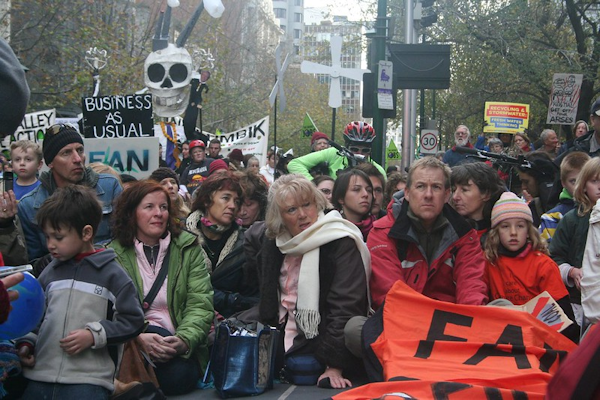SEJournal Online is the digital news magazine of the Society of Environmental Journalists. Learn more about SEJournal Online, including submission, subscription and advertising information.
 |
| Climate impacts are aggravating existing mental health problems and adding new psychological pains, writes the author. Above, climate protestors. Photo: John Englart via Flickr Creative Commons (CC BY-SA 2.0). |
Feature: Why Journalists Should Investigate the Twin Mental Health and Climate Crises
By Bob Doppelt
The United States is in the midst of two crises — one of mental health and one of the climate emergency — that are linked in multiple and complex ways that exacerbate both. Few grasp the connections or their tragic consequences. Journalists can help illuminate these dynamics and what should be done about them.
The organization I coordinate, the International Transformational Resilience Coalition, initially thought individualized services were the solution to climate-generated psychological and emotional problems.
When we realized this would not succeed we launched a deep dive into methods that could counter the forces generating today’s widespread distresses and traumas.
Here’s what we found.
Climate-generated anguish
The latest statistics from the National Institute of Mental Health Disorders reveal an epidemic of mental health troubles.
Nearly one in five adults — almost 53 million people — are struggling with a diagnosed mental disorder. Sixteen percent of youth report suffering from at least one major depressive episode annually.
Millions more adults and youth are experiencing serious undiagnosed anxiety, depression, post-traumatic stress disorder and other symptoms.
The root of many of these struggles, it turns out, is the anguish people are experiencing from pervasive social isolation and loneliness; lack of meaningful living-wage jobs and the loss of dignity this creates; alienation caused by vast social injustices and racism; and other socioeconomic forces.
But the direct and indirect impacts of the climate crisis, including the fear many young people have about what it means for their future, are also aggravating these distresses and adding altogether new psychological and emotional pains.
Although disasters capture our attention,
the most ubiquitous causes of climate-generated
mental health struggles are the toxic stresses
generated by cascading disruptions.
Although disasters capture our attention, the most ubiquitous causes of climate-generated mental health struggles are the toxic stresses generated by cascading disruptions to the ecological, social and economic systems people rely on for food, water, income and other basic needs.
For example, damage and loss of crops due to droughts and heat waves contribute to increased suicides among farmers, disrupting local farm communities and stressing millions of others due to higher food prices and increased food insecurities.
Mixed with these stressors are the acute traumas generated by more frequent and extreme disasters and emergencies. Disasters already impact over 47 million Americans annually. They can traumatize 20-40% of those who are directly affected, as well as 10-20% of others who just view the events (including journalists).
The number of people traumatized by disasters often exceeds those who are physically injured by 40-1.
Their struggles, however, rarely receive much attention. This invisibility reflects society's values: external physical factors over internal human well-being, and machismo over any hint of emotional struggles.
Climate traumas block climate solutions
These conditions are generating poisonous consequences. Suicides are rising among both adults and youth. Many people are trying to dull their pain through drugs or alcohol and become addicted.
 |
| It is almost impossible for stressed and traumatized people to grasp complex issues like the climate crisis. Photo: Sander van der Wel via Flickr Creative Commons (CC BY-SA 2.0). |
Others are turning their distress on their spouses or children. Still others are blaming someone else and becoming socially divisive or violent.
These reactions are undermining the health, safety and well-being of people everywhere. They are also obstructing climate solutions.
When humans feel threatened, the “executive center” of the brain shuts down to focus all of the body’s energy on self-defense. This makes it almost impossible for stressed and traumatized people to grasp complex issues like the climate crisis, let alone worry about their environmental impacts.
They will also often oppose anything perceived as ominous, such as phasing out fossil fuels to reduce global temperatures.
In sum, we found that opposition to climate solutions is not always a purely ideological issue. It is often a gut reaction people have to things gone wrong in their lives.
And just as people who lack close social bonds or economic opportunities can be lured into violent gangs, populist opposition to climate solutions sometimes results not from any particular political belief but from the desperate need to belong to a group that gives their lives meaning and purpose.
Left unaddressed, as temperatures rise, these harmful reactions will grow far worse.
A public health approach
Fortunately, as we searched for solutions, a comment by the noted pioneer clinical psychologist Dr. George Albee became preeminent: “No epidemic has ever been resolved by paying attention to the treatment of the affected individual."
This led us to realize that although individualized services will remain important, a public health approach is what’s needed to address today’s interlinked challenges.
A public health approach focuses on the entire population, with different but connected interventions for people deemed at greater risk and those already experiencing symptoms of pathology.
We must think and act
through a population lens,
not an individual one.
We must think and act through a population lens, not an individual one.
The top priority is to prevent mental health problems before they emerge. This is achieved by strengthening protective factors that help people to buffer themselves from, and push back against, traumatic stressors and to remain psychologically and emotionally healthy and resilient during hardships.
Group and community-minded healing methods like healing circles are integrated into the prevention strategies. This approach to public health, we found, is most effective when applied at the community level.
We discovered many such initiatives underway in small towns like Walla Walla, Washington, and Tarpon Springs, Florida, and in large cities such as San Francisco and Edmonton in Alberta, Canada.
Most establish the “social infrastructure,” often called a resilience coordinating network, that engages numerous individuals, groups and organizations in devising strategies that help all residents strengthen their capacity for mental wellness and resilience during adversities.
As one leader, Robin Saenger, founder and director of Peace4Tarpon in Tarpon Springs told me, “Community is the big deal. The human infrastructure is where the action is at."
Resilience and responsibility
Each community’s approach is unique. Almost all, however, focus on building social connections throughout the area. These relationships reduce the toxic social isolation that undermines mental health today. They also provide the practical assistance and emotional support needed in emergencies.
Another common focus is helping residents understand how traumatic stresses can affect them, along with teaching them simple self-regulation skills to calm their body, mind and emotions when they are distressed.
Still another is helping residents find new meaning, purpose and hope in life by engaging in something bigger than themselves, such as assisting others in need or establishing healthy and just, low-emission, climate-resilient conditions in their community.
Community helps residents remain
healthy and resilient, and residents
help the community and often the
natural environment to do the same.
In short, these initiatives show that resilience and responsibility to others and place are one. Community helps residents remain healthy and resilient, and residents help the community and often the natural environment to do the same.
These findings led us to work with U.S. Rep. Paul Tonko, D-N.Y., on a bipartisan bill that will direct the Centers for Disease Control and Prevention to fund communities that use a public health approach to build population mental wellness and resilience. We believe it can become law this Congress.
The Community Mental Wellness and Resilience Act of 2023 will be introduced in the House as a bipartisan bill by Reps. Tonko and Brian Fitzpatrick, R-Pa., and co-sponsors — and simultaneously in the Senate by Sen. Ed Markey, D-Ma., and co-sponsors.
The introduction is currently planned for the first week of May to correspond to Mental Health Month. An even stronger version is included in the Green New Deal for Health bill that was introduced in the Senate by Sen. Markey on April 20.
I also wrote a book titled “Preventing and Healing Climate Trauma: A Guide to Building Resilience and Hope in Communities,” which examines the relationship between the climate and mental health crises, and how to address the issues in much more depth.
Emission reduction policies are needed to manage the climate crisis. Equally important, however, is the need to use a public health approach in communities to build social connections, give people voice, enhance individual and collective efficacy, and foster shared meaning, purpose and hope in the face of climate adversities.
[Editor's Note: For a deeply personal exploration of climate grief by Society of Environmental Journalists' Editorial Advisory Board Member Michael Kodas, read his April 22, 2023, Inside Climate News piece on the self-immolation death of climate protestor and former student Wynn Bruce outside the Supreme Court on Earth Day in 2022.]
Bob Doppelt coordinates the International Transformational Resilience Coalition, a network of mental health, human services, climate and other organizations working to prevent and heal climate-generated mental health problems. His new book, “Preventing and Healing Climate Trauma: A Guide for Building Resilience and Hope in Communities,” is available from Taylor and Francis/Routledge Publishing. To connect with Doppelt, email him at tr@trig-cli.org.
* From the weekly news magazine SEJournal Online, Vol. 8, No. 17. Content from each new issue of SEJournal Online is available to the public via the SEJournal Online main page. Subscribe to the e-newsletter here. And see past issues of the SEJournal archived here.













 Advertisement
Advertisement 



